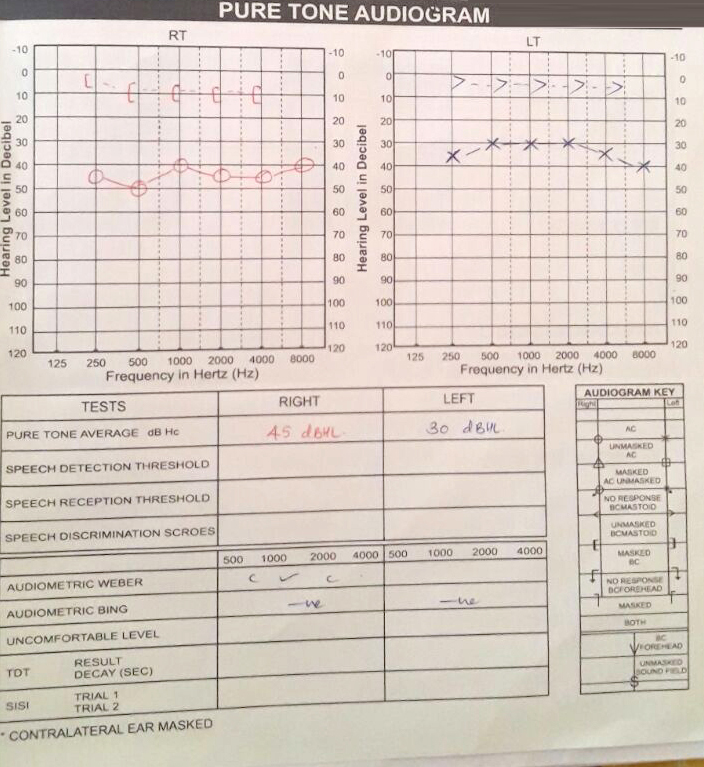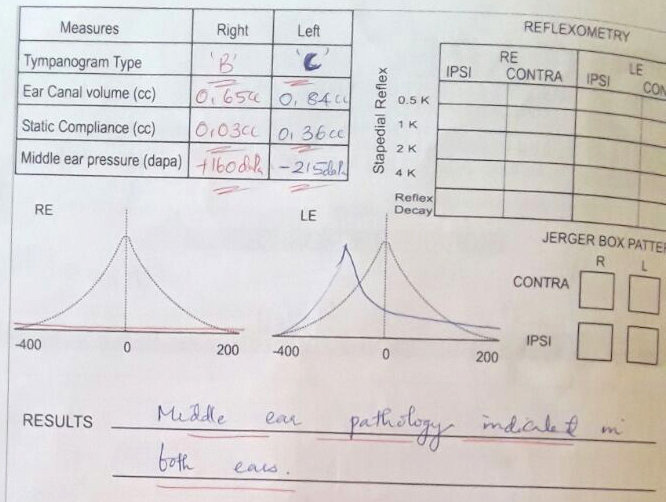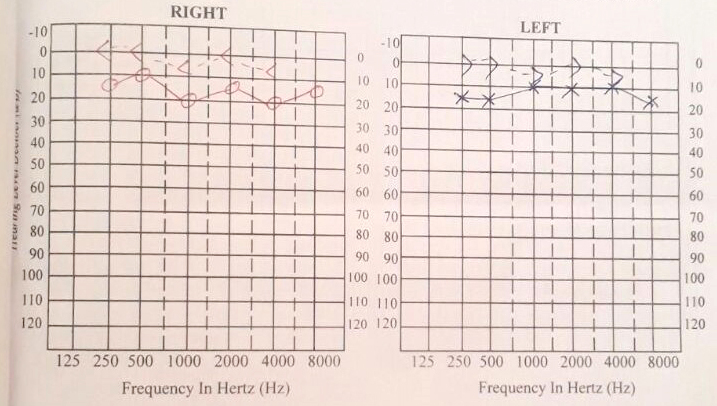Resolution of Fluid and Normalised Hearing Sensitivity in Otitis Media with Effusion by Ayurveda Management
K Sivabalaji1, Sundararaman2, BN Ashwini3
1 Assistant Professor, Department of Shalakya Tantra, School of Ayurveda, Amrita University, Amritapuri, Kerala, India.
2 Director and Chief Physician, Nilgiris Ayurveda Treatment Centre Pvt Ltd, Coonoor, Kerala, India.
3 Associate Professor, Department of Shalakya Tantra, School of Ayurveda, Amrita University, Amritapuri, Kerala, India.
NAME, ADDRESS, E-MAIL ID OF THE CORRESPONDING AUTHOR: Dr. K Sivabalaji, Assistant Professor, School of Ayurveda, Amrita University, Amritapuri, Clappana P.O. Kerala-690525, India.
E-mail: balajisiva85k@gmail.com
The current treatment modality for otitis media with effusion is surgical intervention but recurrence is common. This case report discusses the Ayurvedic treatment of a case diagnosed as otitis media with effusion, which was posted for myringotomy with grommet insertion. A five-year-old boy on antihistamines and antibiotics for 3 months presented with constant hearing loss and difficulty with speech discrimination. The features suggestive of otitis media with effusion were diagnosed by pure tone audiometry and tympanogram. Ayurveda medication was started and surgery was deferred because the patient responded positively. The 45 dB and 30 dB conductive hearing loss detected by audiometry improved to 15 dB and 11.6 dB, which is within normal limits. The patient became asymptomatic and recovered his sense of hearing. Till date, there has been no recurrence. Non-surgical intervention of otitis media with effusion demonstrated normalised hearing sensitivity and relief from symptoms. Validation should be further conducted using larger studies.
Audiometry, Badhirya, Glue Ear
Case Report
A five-year-old boy presented with a 3-month history of hearing loss in both ears. He was diagnosed with otitis media with effusion on 28/11/2016. The patient was administered anti-histamines and antibiotics for 3 months but did not improve, so his parents approached us for Ayurveda treatment. Family history was non-significant. On general examination, all vital signs were within normal limits.
Pure tone audiometry showed 45 dB and 30 dB hearing loss in right and left ear respectively, which is suggestive of moderate conductive hearing loss. Tympanometry of the right ear demonstrated a Type B graph (suggestive of middle ear involvement from fluid), while the left ear demonstrated a type C graph (suggestive of Eustachian tube dysfunction often before or after effusion).
Local examination of both external ears showed normal pinnae. Otoscope examination revealed a normal external auditory canal and skin with no sign of inflammation, wax, foreign body, or growth. Tympanic membrane revealed a pearly grey colour and distortion of cone of light. Siegal’s speculum demonstrated hampered mobility of the tympanic membrane in both ears. The fluid level was appreciated in the tympanic membranes of both ears. Rinne’s test showed that bone conduction was greater than air conduction in both ears, while Weber’s test was lateralised to the right ear [1]. The patient underwent medical management with a variety of anti-histamines and antibiotics for three months but did not get any relief. As the disease was not controllable he was advised for myringotomy with grommet insertion. Routine haematological investigation was found to be within normal limits. The patient’s father was not willing for surgery, so he switched to a contemporary management.
Various Ayurvedic interventions were adapted to treat this patient. On the first visit (11/2/2017) Gorochanadivati 125 mg was started orally twice a day, Dasamoolarishtam 10 mL thrice a day, Guggulu panchapala choorna 5 gm twice a day, Anu taila 2 drops in each nostril were prescribed for three months. On 2nd month follow up (18/3/2017) Haridra khanda 5 gm twice a day with Luke warm milk was added. On 3rd visit (8/4/2017) Sarivadivati 375 mg twice a day was given [Table/Fig-1] [2-7].
Ayurveda treatment details [2-7].
| Name of the drug used orally | Composition | Dose | Anupana | Days of treatment |
|---|
| GorochanadiVati [2] | Gorochana, trikatu, triphala, nagabhasama, lasuna, mrgasrnga and other 40 herbs | 125 mg twice a day | Hot water | From 11/2/17-9/5/17 |
| Dasamoolarishtam [3] | Fermented extract of Dasamoola and 60 other herbs | 10 mL thrice a day | Warm water | 11/2/17-9/5/17 |
| HaridraKhanda [4] | Haridra, trikatu, ela, dalicini, Vidanga, trivrit, triphla, nagakeseraMusta, lauhabhasma, ghrita, cow’s milk | 5 gm twice a day | Warm milk | 18/3/17-9/5/17 |
| SarivadiVati [5] | Sariva, kustha, triphala, nagakesara,Loha, Abhrakabhasma, guduchi, patra, Ela | 375 mg twice a day | Warm water | 8/4/17-9/5/17 |
| Guggulu panchapala choorna [6] | Guggulu, magadhika, triphalaTwak, truti | 5 gm twice a day | Honey | 11/2/17-9/5/17 |
| Anu taila [7] | Jivanti, jala, devadaru, twak, darvi, madhuka, aguru, bala, kamala, tilathaila, rain water | 2 drops in each nostril | | 11/2/17-9/5/17 |
The patient was advised monthly follow-up for three months, after which Pure Tone Audiometry was administered. Before treatment, Pure Tone Audiometry (28/1/2017) showed 45 dB and 30 dB hearing loss in right and left ear respectively [Table/Fig-2]. Tympanometry showed Type B graph in right ear and type C graph in left ear [Table/Fig-3].


After three months of medication, as per the patient there was improvement in hearing and speech. Pure tone Audiometry (repeated on 11/5/2017) showed improvement to 15 dB in right ear and 11.6 dB in left ear, which is within normal limits [Table/Fig-4].
Repeat pure tone audiometry.

Tympanometry (repeated on 11/5/2017) shows graph Type ‘C’ in both ears. Patient was symptom free with no evidence of otitis media with effusion.
Discussion
Otitis Media with Effusion (OME) is characterised by a non-purulent effusion of the middle ear which includes hearing loss, delayed and defective speech [8]. Eighty percent of children have at least one episode of Otitis media with effusion by the age of 10 years [9].
Functionally, the middle ear is closely related to the nasopharynx through the Eustachian tubes. The tensor veli palatini muscle opens the Eustachian tube and facilitates both ventilation of the middle ear and drainage of secretions from it. The Eustachian tube also protects the middle ear from excessive sound pressure and secretions from the nasopharynx. Dysfunction of the Eustachian tube has an important role in the manifestation of middle ear diseases [10]. The loss is usually conductive, with an average air conduction threshold of 27.5 decibels (dB). Management includes decongestants, anti-histamines, steroids and antibiotics. It’s to be employed for removal of fluid and prevention of occurrences but is of no assistance in the presence of thickened fluid. Thickened fluid must be surgically removed. Although surgical intervention significantly improves the clearance of middle ear effusion, the benefits for speech and language development as well as quality of life remain controversial [11].
As per Ayurveda, Badhirya is of two types, viz., Vataja and Vata-Kaphaja. Acharya Vagbhata stresses the importance of Pratishyaya Chikista in the context of Badhirya Cikitsa [12]. This case was diagnosed as Vata-Kaphaja Badhirya. Kapha in the form of fluid obstructs the passage of Vata (sound waves) in the Karna Srotas. Normalising Kapha Dosha (absorption/resolution of the fluid in the middle ear) can automatically channelize the Vata Dosha and ensure proper conduction of sound waves. Thus, the treatment protocol was planned to pacify Kapha so as to regulate movement of Vata and re-establish hearing.
Eustachian tubes connect the nasopharynx and the middle ear; hence proper functioning of the tube is needed for drainage of secretions from the middle ear. Reflux secretions from the nasopharynx into the middle ear are prevented by this tube. Reflux of the secretions occurs if the tube is wide and short. Upper respiratory tract infections are one of the cause for the malfunctioning of the Eustachian tube. Hence, Pratishyaya Chikitsa is important in the management of Badhirya. Vata and kapha are involved in both Badhirya and Pratishyaya.
In terms of dhatu, increase in rasa dhatu will have the features of Kapha vridhi. In Kapha vridhi, the features mentioned as Swasa and Kasa which again signifies the respiratory tract involvement which is an important factor in middle ear diseases [13]. Hence, increase of Kapha dosha in the form of Rasa dhatu will cause Avarana (occlusion) to Vatadosha. Thereby leading to vatavridhi and also can directly causes Kasa and Swasa which is one of the important factors in the manifestation of Karna Roga.
Internal medications were selected from Badhirya and Pratishyaya Chikitsa. Guggulu Panchaphala Choorna is indicated in Nadi Vrana was given considering the Karna as Srotas and the middle ear lesion as Vrana. The same medication also relieves Kapha AvrutaVata (Kapha blocking the movement of vata). GorochanadiGutika administered in SravanaLopa (hearing impairment) rectifies hearing loss. Dasamoolaristam pacifies Kapha and equilibrizes VataDosha. SarivadiVati normalises and regulates movement of Vata and helps to regain hearing. Haridra Khanda was to counteract allergies. Anutaila was nasally to counter Pratishyaya and to strengthen Indriyas [14].
Conclusion
Serous otitis media can be considered as Vata-KaphajaBadhirya. Kapha in the form of fluid restricts the movements (vata) of sound waves. Normalising kapha and channelizing vata will restore the sense of hearing. Pratishyaya Chikitsa should also be adopted. On this principle, studies should be conducted to validate the management of this condition. Further studies are needed to assess the sustained results.
Patient Consent: The patient’s father has provided written consent and gives permission to publication. This has been documented.
[1]. Wakode PT, Clinical Methods in ENT 2005 1st edNew DelhiJaypee Brothers Medical publishers (P) Ltd:31-39. [Google Scholar]
[2]. Mishra B, Bhaisayaratnavali of Govinda Dasji (with “Shastri” commentary by Ambikadatta) 2009 Vol. 3Varanasi, IndiaChaukhambha Sanskrit Sansthan:747 [Google Scholar]
[3]. Mishra B, Bhaisayaratnavali of Govinda Dasji (with “Shastri” commentary by Ambikadatta) 2009 Vol. 3Varanasi, IndiaChaukhambha Sanskrit Sansthan:559 [Google Scholar]
[4]. Mishra B, Bhaisayaratnavali of Govinda Dasji (with “Shastri” commentary by Ambikadatta) 2009 Vol. 3Varanasi, IndiaChaukhambha Sanskrit Sansthan:105 [Google Scholar]
[5]. Mishra B, Bhaisayaratnavali of Govinda Dasji (with “Shastri” commentary by Ambikadatta) 2009 Vol. 3Varanasi, IndiaChaukhambha Sanskrit Sansthan:243 [Google Scholar]
[6]. Paradkar H, Ashtanga Hridaya of Vagbhata (with the commentaries “SarvangaSundara” of Arunadatta and “Ayurveda Rasayana” of Hemadri) 2005 Varanasi, IndiaChaukhmbaSurbharatiPrakashana:880 [Google Scholar]
[7]. Paradkar H, Ashtanga Hridaya of Vagbhata (with the commentaries “SarvangaSundara” of Arunadatta and “Ayurveda Rasayana” of Hemadri) 2005 Varanasi, IndiaChaukhmbaSurbharatiPrakashana:293 [Google Scholar]
[8]. Dhingra PL, Dhingra S, Diseases of Ear, Nose and Throat 2010 5th edNew DelhiReed Elsevier India Private Limited:69-73. [Google Scholar]
[9]. https://www.ncbi.nlm.nih.gov/pmc/articles/PMC4170480 [Google Scholar]
[10]. Bansal M, Essentials of Ear, Nose and Throat 2016 1st edNew DelhiJaypee Brothers Medical Publishers (P) Ltd:9610.5005/jp/books/12739_2 [Google Scholar] [CrossRef]
[11]. Bansal M, Essentials of Ear, Nose and Throat 2016 1st edNew DelhiJaypee Brothers Medical Publishers (P) Ltd:101-04.10.5005/jp/books/12739_13 [Google Scholar] [CrossRef]
[12]. Paradkar H, Ashtanga Hridaya of Vagbhata (with the commentaries “SarvangaSundara” of Arunadatta and “Ayurveda Rasayana” of Hemadri) 2005 Varanasi, IndiaChaukhmbaSurbharatiPrakashana:838 [Google Scholar]
[13]. Paradkar H, Ashtanga Hridaya of Vagbhata (with the commentaries “SarvangaSundara” of Arunadatta and “Ayurveda Rasayana” of Hemadri) 2005 Varanasi, IndiaChaukhmbaSurbharatiPrakashana:183 [Google Scholar]
[14]. Paradkar H, Ashtanga Hridaya of Vagbhata (with the commentaries “SarvangaSundara” of Arunadatta and “Ayurveda Rasayana” of Hemadri) 2005 Varanasi, IndiaChaukhmbaSurbharatiPrakashana:293 [Google Scholar]